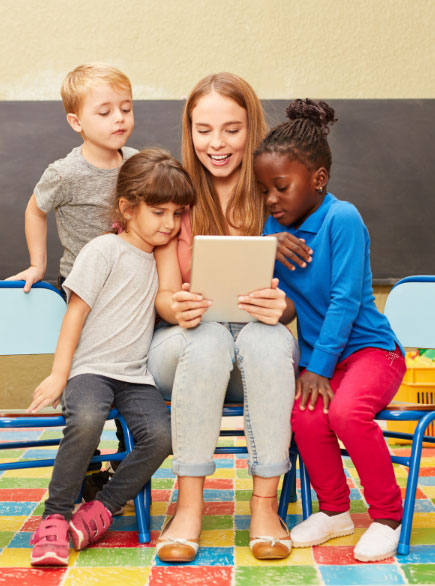Education is evolving rapidly in the digital age, and toddlers are no exception. Ebooks, or electronic books, have become a valuable tool in the nursery classroom, providing an interactive and stimulating learning experience for our young learners. In this article, we’ll look in detail at the benefits of using ebooks in the nursery classroom and how they can contribute to the development of essential skills in young children.

1. Stimulating interest in reading
Using ebooks in kindergarten classes can awaken children’s curiosity about books. The colourful images, animations and interactive stories capture their attention and encourage them to explore the world of reading. What’s more, most digital books contain audio features to support young learners’ reading. Children can read while listening, and even have words repeated if necessary. For younger children, this means they can gradually learn to recognise letters and sounds by associating what they hear with what they see.
2. Encouraging multimodal learning
The ebooks combine text, images, sound and video, providing a multimodal learning experience. This allows children to explore different learning styles and develop a deeper understanding of concepts. These multimedia features capture the attention of young children and encourage them to actively engage with the story (Nikolajeva, 2013). This interaction makes reading more fun and engaging, fostering a lasting interest in books.
3. Individualising teaching and encouraging independence
Each child develops at his or her own pace, and ebooks allow teachers to tailor teaching to individual needs. Activities and interactive exercises can be personalised for each child, offering targeted support. This personalisation allows children to read books adapted to their abilities, boosting their confidence and motivation to read (Bonn, 2013).
In addition, ebooks in the nursery classroom encourage children to explore and learn independently. Toddlers can navigate pages, press buttons to get answers, and progress at their own pace, boosting their self-confidence.

4. Preparing for technology
Using ebooks from kindergarten introduces children to technology at an early age. It prepares them for a constantly changing digital world and strengthens their digital skills. It helps them become familiar with digital interfaces and develop basic skills in navigating and manipulating these technological tools (Rideout et al., 2017). In addition, ebooks introduce children to basic digital literacy concepts, such as understanding icons, buttons and interactive menus (Haugland, 2000). This early familiarity with the principles of navigation and digital interaction is a key element of technology readiness (Plowman et al., 2010).

5. Encouraging communication and social interaction
The ebooks can also be used for group activities, encouraging communication and social interaction between children. They can work together to solve puzzles, share discoveries and tell stories.
The use of ebooks in the nursery classroom therefore offers a host of advantages for young children. They stimulate interest in reading, promote multi-modal learning, individualise teaching, encourage independence and prepare children for an ever-changing digital world. By combining the best of technology with the developmental needs of toddlers, ebooks have become a powerful tool for early childhood educators, helping to prepare our young learners for a promising future.

Bibliography
Bonn, S. (2013). Fostering children’s listening comprehension with tablet computers: A design-based research study. Journal of Educational Multimedia and Hypermedia, 22(2), 151-171.
Haugland, S. W. (2000). What role should technology play in young children’s learning? Young Children, 55(1), 12-17.
Nikolajeva, M. (2013). Picturebooks and digital media in the classroom: The future of the book. Literature for Children and Young Adults in a Digital Age, 33-45.
Plowman, L., McPake, J., & Stephen, C. (2010). The technologization of childhood? Young children and technology in the home. Children & Society, 24(1), 63-74.
Rideout, V., Saphir, M., Pai, S., Rudd, A., Lowery, N., & Michael, D. (2017). The Common Sense census: Media use by kids age zero to eight. Common Sense Media.
